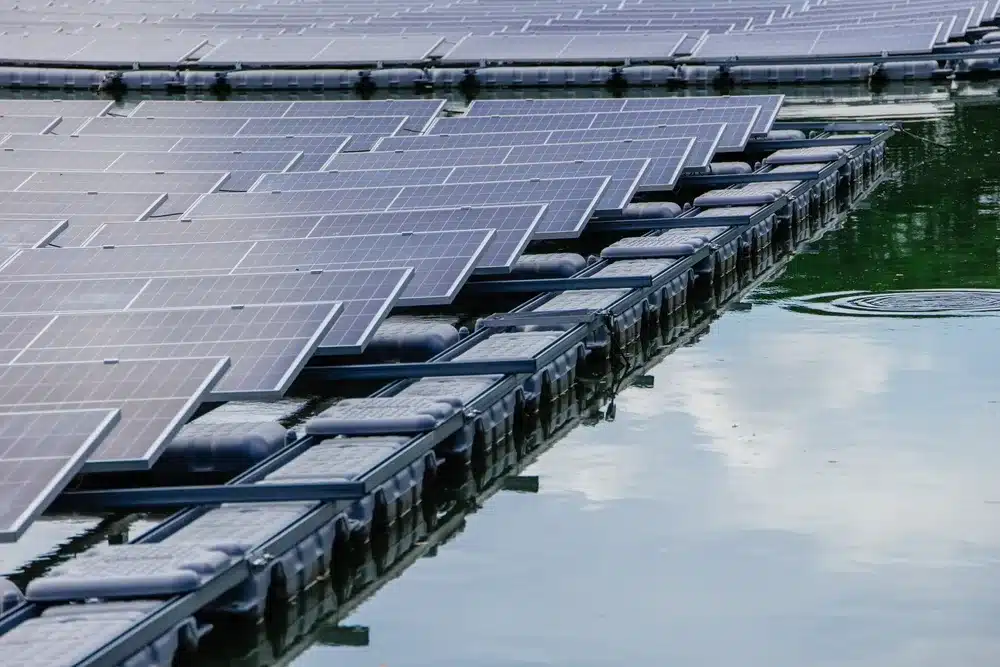Table of Contents
Liberty Solar Energy Corp. (LSEC), a subsidiary of Alternergy Holdings Corp., is preparing to build a 100-megawatt alternating current (MWac) floating solar farm in Paniqui, Tarlac, an investment worth ₱8.8 billion and among the largest of its kind proposed in the country.
The project, which secured a contract under the Department of Energy’s (DOE) fourth Green Energy Auction (GEA-4), will rise on a 144-hectare property in Barangay San Isidro, much of it currently used as fishponds. LSEC disclosed the plan in filings with the Environmental Management Bureau.
Optimizing Benefits Of Renewables
Floating solar farms, or floating photovoltaics (FPVs), are large installations of solar panels that are mounted on floating structures and placed on bodies of water. They help maximize renewable energy output without competing with agriculture or urban development.
They also come with the added benefit of reducing evaporation in the surrounding waters, which helps prevent droughts.
LSEC plans to install a total capacity of 140 megawatt peak (MWp), equivalent to 99.8 MWac, to be implemented in two equal phases of 70 MWp (49.9 MWac) each. The company said the solar facility will supply electricity directly to the Luzon grid and contribute to meeting the region’s fast-growing demand.
Large-Scale Investment
Construction is scheduled to begin in the second quarter of 2026 and run until the second quarter of 2027. Commercial operations are targeted for the third quarter of 2027. At the peak of construction, the project is expected to employ around 1,000 workers; regular operations will require about 50 staff.
According to LSEC, the investment will cover detailed engineering design, feasibility studies, permitting, site preparation, equipment procurement, construction of the power plant and support facilities, and environmental management measures.
Aligned With National Energy Goals
The company said the plan supports the government’s transition to cleaner energy sources and aligns with priorities under the Philippine Energy Plan (PEP) 2023–2050. The PEP projects a sharp rise in power consumption, with total electricity sales expected to increase from 91.3 terawatt-hours (TWh) in 2022 to 408.11 TWh by 2050, for an annual average growth rate of 5.5 percent.
Peak demand nationwide is forecast to triple from 16.6 gigawatts (GW) to 68.5 GW within the same period, with the Luzon grid accounting for about 70 percent of the total. To meet this growth, the country will need an additional 122.7 GW of generation capacity by 2050.
Renewable energy is a central component of the DOE’s long-term strategy. The government aims for at least a 35-percent share of renewables in the power generation mix by 2030 and 50 percent by 2040. Solar output, in particular, is projected to expand from 1.8 TWh in 2022 to 73.7 TWh by mid-century.
Environmental Safeguards
LSEC stated that it will prepare a comprehensive environmental management plan encompassing mitigation and monitoring measures throughout the project’s development. The company added that the floating solar installation is designed to coexist with surrounding water resources while adhering to environmental regulations.
With its GEA-4 award and multibillion-peso investment plan, the project positions Tarlac as a potential site for large-scale renewable energy expansion as the Philippines accelerates its shift toward cleaner and more flexible power sources.
Sources:
https://businessmirror.com.ph/2025/11/07/lsec-plans-to-build-floating-solar-farm
https://www.eco-business.com/news/will-floating-solar-prove-pivotal-in-archipelagic-philippines

